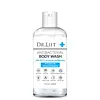What's inside
What's inside
 Key Ingredients
Key Ingredients

 Benefits
Benefits

 Concerns
Concerns

 Ingredients Side-by-side
Ingredients Side-by-side

Benzalkonium Chloride 0.13%
AntimicrobialWater
Skin ConditioningSodium C14-16 Olefin Sulfonate
CleansingCocamidopropyl Betaine
CleansingGlycerin
HumectantGuar Hydroxypropyltrimonium Chloride
Skin ConditioningSodium Chloride
MaskingHumulus Lupulus Extract
AntimicrobialLavandula Angustifolia Flower/Leaf/Stem Extract
MaskingCalendula Officinalis Flower Extract
MaskingChamomilla Recutita Flower Extract
MaskingCitrus Limon Peel Extract
EmollientCucumis Sativus Seed Extract
Skin ConditioningCamellia Sinensis Leaf Extract
AntimicrobialPyrus Malus Fruit Extract
Skin ConditioningSpirulina Platensis Extract
Skin ProtectingCitric Acid
BufferingDehydroacetic Acid
PreservativeBenzyl Alcohol
PerfumingParfum
MaskingBenzalkonium Chloride 0.13%, Water, Sodium C14-16 Olefin Sulfonate, Cocamidopropyl Betaine, Glycerin, Guar Hydroxypropyltrimonium Chloride, Sodium Chloride, Humulus Lupulus Extract, Lavandula Angustifolia Flower/Leaf/Stem Extract, Calendula Officinalis Flower Extract, Chamomilla Recutita Flower Extract, Citrus Limon Peel Extract, Cucumis Sativus Seed Extract, Camellia Sinensis Leaf Extract, Pyrus Malus Fruit Extract, Spirulina Platensis Extract, Citric Acid, Dehydroacetic Acid, Benzyl Alcohol, Parfum
Water
Skin ConditioningSodium C14-16 Olefin Sulfonate
CleansingCocamidopropyl Betaine
CleansingGlycerin
HumectantMandelic Acid
AntimicrobialButylene Glycol
HumectantHydroxyethylcellulose
Emulsion StabilisingPlant Ash Extract
Gold
Cosmetic ColorantCymbopogon Schoenanthus Oil
MaskingHamamelis Virginiana Water
AstringentPunica Granatum Seed Powder
AbrasiveCamellia Sinensis Leaf Extract
AntimicrobialPhenoxyethanol
PreservativeEthylhexylglycerin
Skin ConditioningWater, Sodium C14-16 Olefin Sulfonate, Cocamidopropyl Betaine, Glycerin, Mandelic Acid, Butylene Glycol, Hydroxyethylcellulose, Plant Ash Extract, Gold, Cymbopogon Schoenanthus Oil, Hamamelis Virginiana Water, Punica Granatum Seed Powder, Camellia Sinensis Leaf Extract, Phenoxyethanol, Ethylhexylglycerin
Ingredients Explained
These ingredients are found in both products.
Ingredients higher up in an ingredient list are typically present in a larger amount.
Camellia Sinensis Leaf Extract is derived from the leaves of the tea plant. Black tea, green tea, and oolong tea are all harvested from this plant.
This ingredient has many skin benefits:
This ingredient contains polyphenols, a strong antioxidant. Antioxidants help fight off molecules that damage skin cells.
On top of that, the antioxidants in green tea neutralize free-radicals from the sun. This gives the skin some extra UV protection, but should not replace sunscreen.
Many components of tea have anti-inflammatory properties.
Polyphenols and L-theanine help soothe the skin and reduce irritation. The caffeine in Camellia Sinensis Leaf Extract helps calm inflamed blood vessels.
Other compounds found in tea include: Vitamin Bs, linoleic acid, magnesium, calcium, iron, and zinc.
Research has shown both drinking Camellia Sinensis Leaf Tea and applying it to the skin can help boost skin elasticity and hydration. Studies also show using tea extract may reduce sebum, or oil, production.
Learn more about Camellia Sinensis Leaf ExtractCocamidopropyl Betaine is a fatty acid created by mixing similar compounds in coconut oil and dimethylaminopropylamine, a compound with two amino groups.
This ingredient is a surfactant and cleanser. It helps gather the dirt, pollutants, and other impurities in your skin to be washed away. It also helps thicken a product and make the texture more creamy.
Being created from coconut oil means Cocamidopropyl Betaine is hydrating for the skin.
While Cocamidopropyl Betaine was believed to be an allergen, a study from 2012 disproved this. It found two compounds in unpure Cocamidopropyl Betaine to be the irritants: aminoamide and 3-dimethylaminopropylamine. High-grade and pure Cocamidopropyl Betaine did not induce allergic reactions during this study.
Learn more about Cocamidopropyl BetaineGlycerin is already naturally found in your skin. It helps moisturize and protect your skin.
A study from 2016 found glycerin to be more effective as a humectant than AHAs and hyaluronic acid.
As a humectant, it helps the skin stay hydrated by pulling moisture to your skin. The low molecular weight of glycerin allows it to pull moisture into the deeper layers of your skin.
Hydrated skin improves your skin barrier; Your skin barrier helps protect against irritants and bacteria.
Glycerin has also been found to have antimicrobial and antiviral properties. Due to these properties, glycerin is often used in wound and burn treatments.
In cosmetics, glycerin is usually derived from plants such as soybean or palm. However, it can also be sourced from animals, such as tallow or animal fat.
This ingredient is organic, colorless, odorless, and non-toxic.
Glycerin is the name for this ingredient in American English. British English uses Glycerol/Glycerine.
Learn more about GlycerinSodium C14-16 Olefin Sulfonate is a cleansing agent made from a mixture of long chain sulfonate salts. It can also help produce foam.
This ingredient may be drying. We recommend speaking with a professional if you have concerns.
Water. It's the most common cosmetic ingredient of all. You'll usually see it at the top of ingredient lists, meaning that it makes up the largest part of the product.
So why is it so popular? Water most often acts as a solvent - this means that it helps dissolve other ingredients into the formulation.
You'll also recognize water as that liquid we all need to stay alive. If you see this, drink a glass of water. Stay hydrated!
Learn more about Water